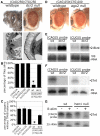Triplet repeat-derived siRNAs enhance RNA-mediated toxicity in a Drosophila model for myotonic dystrophy
- PMID: 21437269
- PMCID: PMC3060073
- DOI: 10.1371/journal.pgen.1001340
Triplet repeat-derived siRNAs enhance RNA-mediated toxicity in a Drosophila model for myotonic dystrophy
Abstract
More than 20 human neurological and neurodegenerative diseases are caused by simple DNA repeat expansions; among these, non-coding CTG repeat expansions are the basis of myotonic dystrophy (DM1). Recent work, however, has also revealed that many human genes have anti-sense transcripts, raising the possibility that human trinucleotide expansion diseases may be comprised of pathogenic activities due both to a sense expanded-repeat transcript and to an anti-sense expanded-repeat transcript. We established a Drosophila model for DM1 and tested the role of interactions between expanded CTG transcripts and expanded CAG repeat transcripts. These studies revealed dramatically enhanced toxicity in flies co-expressing CTG with CAG expanded repeats. Expression of the two transcripts led to novel pathogenesis with the generation of dcr-2 and ago2-dependent 21-nt triplet repeat-derived siRNAs. These small RNAs targeted the expression of CAG-containing genes, such as Ataxin-2 and TATA binding protein (TBP), which bear long CAG repeats in both fly and man. These findings indicate that the generation of triplet repeat-derived siRNAs may dramatically enhance toxicity in human repeat expansion diseases in which anti-sense transcription occurs.
Conflict of interest statement
The authors have declared that no competing interests exist.
Figures




Similar articles
-
Muscleblind, BSF and TBPH are mislocalized in the muscle sarcomere of a Drosophila myotonic dystrophy model.Dis Model Mech. 2013 Jan;6(1):184-96. doi: 10.1242/dmm.009563. Epub 2012 Nov 1. Dis Model Mech. 2013. PMID: 23118342 Free PMC article.
-
Length-dependent CTG·CAG triplet-repeat expansion in myotonic dystrophy patient-derived induced pluripotent stem cells.Hum Mol Genet. 2013 Dec 20;22(25):5276-87. doi: 10.1093/hmg/ddt386. Epub 2013 Aug 9. Hum Mol Genet. 2013. PMID: 23933738 Free PMC article.
-
MBNL1 and CUGBP1 modify expanded CUG-induced toxicity in a Drosophila model of myotonic dystrophy type 1.Hum Mol Genet. 2006 Jul 1;15(13):2138-45. doi: 10.1093/hmg/ddl137. Epub 2006 May 24. Hum Mol Genet. 2006. PMID: 16723374
-
CAG repeat RNA as an auxiliary toxic agent in polyglutamine disorders.RNA Biol. 2011 Jul-Aug;8(4):565-71. doi: 10.4161/rna.8.4.15397. Epub 2011 Jul 1. RNA Biol. 2011. PMID: 21593608 Free PMC article. Review.
-
Myotonic dystrophy, when simple repeats reveal complex pathogenic entities: new findings and future challenges.Hum Mol Genet. 2011 Oct 15;20(R2):R116-23. doi: 10.1093/hmg/ddr343. Epub 2011 Aug 5. Hum Mol Genet. 2011. PMID: 21821673 Review.
Cited by
-
Bruno-3 regulates sarcomere component expression and contributes to muscle phenotypes of myotonic dystrophy type 1.Dis Model Mech. 2018 May 21;11(5):dmm031849. doi: 10.1242/dmm.031849. Dis Model Mech. 2018. PMID: 29716962 Free PMC article.
-
Overlapping mechanisms of lncRNA and expanded microsatellite RNA.Wiley Interdiscip Rev RNA. 2021 Jan;12(1):e1634. doi: 10.1002/wrna.1634. Epub 2020 Nov 16. Wiley Interdiscip Rev RNA. 2021. PMID: 33191580 Free PMC article. Review.
-
RNA-mediated toxicity in neurodegenerative disease.Mol Cell Neurosci. 2013 Sep;56:406-19. doi: 10.1016/j.mcn.2012.12.006. Epub 2012 Dec 29. Mol Cell Neurosci. 2013. PMID: 23280309 Free PMC article. Review.
-
Structural studies of CNG repeats.Nucleic Acids Res. 2014 Jul;42(13):8189-99. doi: 10.1093/nar/gku536. Epub 2014 Jun 17. Nucleic Acids Res. 2014. PMID: 24939898 Free PMC article. Review.
-
Ubiquitous expression of CUG or CAG trinucleotide repeat RNA causes common morphological defects in a Drosophila model of RNA-mediated pathology.PLoS One. 2012;7(6):e38516. doi: 10.1371/journal.pone.0038516. Epub 2012 Jun 8. PLoS One. 2012. PMID: 22715390 Free PMC article.
References
-
- Ranum LP, Cooper TA. RNA-mediated neuromuscular disorders. Annu Rev Neurosci. 2006;29:259–277. - PubMed
-
- Orr HT, Zoghbi HY. Annu Rev Neurosci; 2007. Trinucleotide Repeat Disorders. - PubMed
-
- Brook JD, McCurrach ME, Harley HG, Buckler AJ, Church D, et al. Molecular basis of myotonic dystrophy: Expansion of a trinucleotide (CTG) repeat at the 3′ end of a transcript encoding a protein kinase family member. Cell. 1992;68:799–808. - PubMed
-
- Fu YH, Pizzuti A, Fenwick RG, King J, Rajnarayan S, et al. An unstable triplet repeat in a gene related to myotonic muscular-dystrophy. Science. 1992;255:1256–1258. - PubMed
Publication types
MeSH terms
Substances
LinkOut - more resources
Full Text Sources
Other Literature Sources
Molecular Biology Databases
Research Materials

